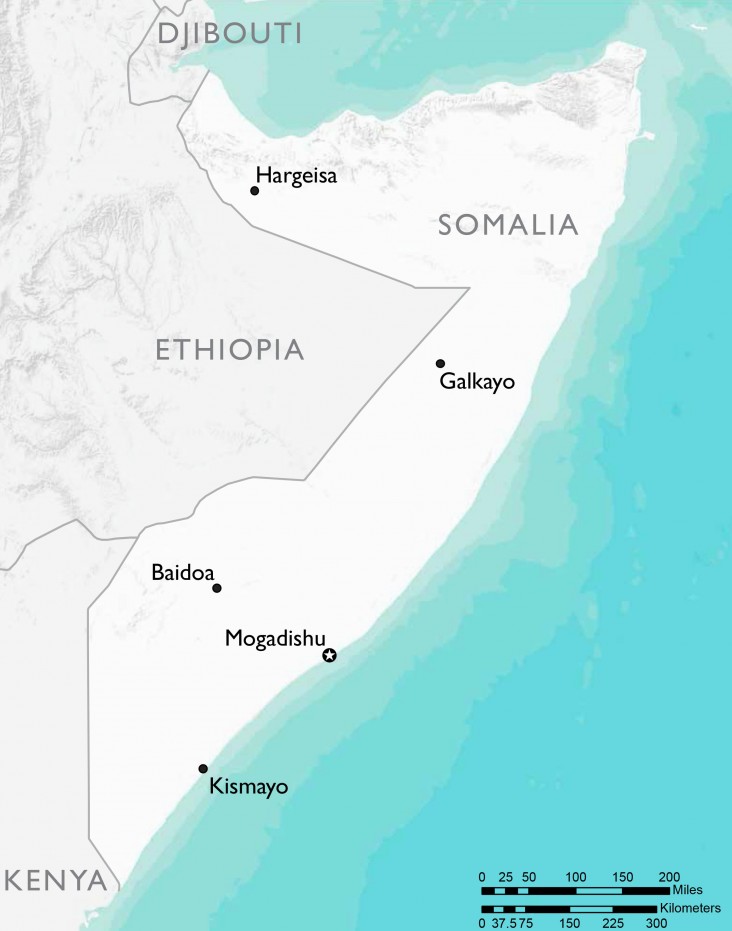Home » What We Do » Agriculture and Food Security » Food Assistance » Country Fact Sheets » Food Assistance Fact Sheet - Somalia
- What We Do
- Agriculture and Food Security
- Democracy, Human Rights and Governance
- Economic Growth and Trade
- Education
- Ending Extreme Poverty
- Environment and Global Climate Change
- Gender Equality and Women's Empowerment
- Global Health
- Water and Sanitation
- Working in Crises and Conflict
- U.S. Global Development Lab

Map of Somalia
USAID
September 22, 2017
Situation
- Following consecutive seasons of poor rainfall, drought conditions persist across most of Somalia. An estimated 3.1 million people are expected to face Crisis—IPC 3—and Emergency—IPC 4 — levels* of acute food insecurity through December 2017, according to the Somalia Food Security and Nutrition Analysis Unit (FSNAU) and the Famine Early Warning Systems Network (FEWS NET). A well-below average July harvest, high staple food prices and large-scale livestock losses are limiting household food availability and income. The October-to-December rains are expected to be average or below-average, leading to continued depletion of pasture and water sources and causing moisture stress on crops.
- Acute malnutrition remains high among vulnerable households, particularly among displaced populations. The national median global acute malnutrition rate is 17.4 percent, an increase in 20 percent over the previous year’s estimate of 14.5 percent. An estimated 388,000 children under 5 are acutely malnourished, including 87,000 who are experiencing severe acute malnutrition (SAM), according to nutrition surveys conducted by FSNAU between June and July 2017.
- Drought continues to drive displacement as people move from rural to urban areas in search of assistance. The UN reports that 859,000 people have been displaced due to drought since November 2016.
- Ongoing humanitarian assistance and localized rainfall have led to a slight decrease in the number of Somalis requiring food assistance. Currently, 6.2 million people are in need of food assistance, compared to FEWS NET and FSNAU reports from May that identified 6.7 million people in need. However, the number of people facing Emergency levels of food insecurity has increased and the risk of Famine—IPC 5—remains. Continued large-scale humanitarian assistance will be required to prevent further deterioration in food security.
*The Integrated Food Security Phase Classification (IPC) is a standardized tool that aims to classify the severity and magnitude of food insecurity. The IPC scale, which is comparable across countries, ranges from Minimal—IPC 1—to Famine—IPC 5.
Response
- The USAID Office of Food for Peace (FFP) targets food-insecure Somali households and IDP populations countrywide with emergency food and nutrition assistance. FFP partners with the UN World Food Program (WFP), other public international organizations and non-governmental organizations on relief, nutrition, livelihoods, social safety net and resilience-oriented activities. These activities include in-kind food assistance as well as cash- and market-based interventions such as cash transfers for food, cash-for-work activities, food vouchers and vocational training.
- Through the UN Children’s Fund (UNICEF), FFP also provides in-kind Ready-to-Use Therapeutic Foods (RUTF) for treatment of severe acute malnutrition, as well as support for enhanced bottleneck analysis of SAM programming, nutrition supply chain integration into health systems, and monitoring and evaluation of program activities.
Food for Peace Contributions
Total Contributions:
| U.S.Dollars | Metric Tons | |
| Fiscal Year 2017 | $239.4 million | 56,720 MT |
| Fiscal Year 2016 | $71.0 million | 20,080 MT |
| Fiscal Year 2015 | $111.3 million | 40,655 MT |
Related Resources
Horn of Africa Complex Emergency Fact Sheet
Food for Peace Success Story - Building Resilience in Somalia (December 20, 2016)
Food for Peace Success Story - Confronting El Nino in Somalia (August 5, 2016)







Comment
Make a general inquiry or suggest an improvement.